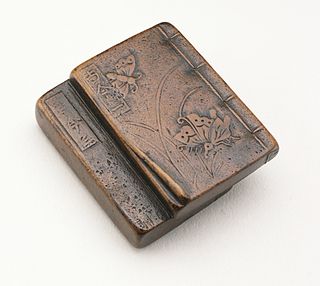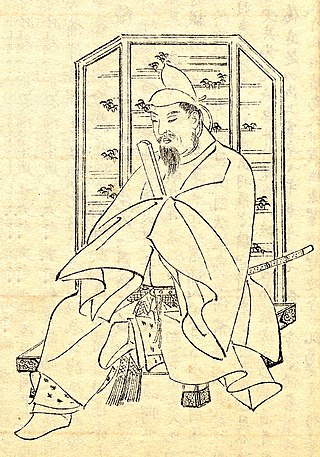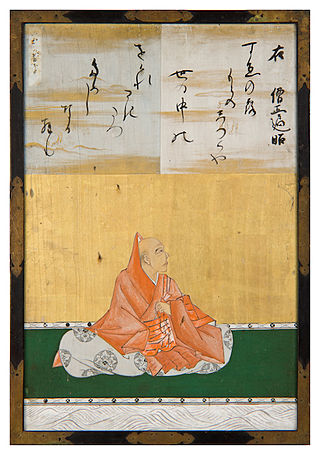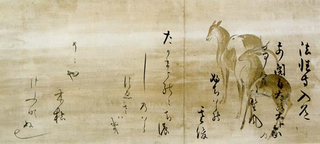Related Research Articles

Kemari (蹴鞠) is an athletic game that was popular in Japan during the Heian (794–1185) and Kamakura period (1185–1333). It resembles a game of keepie uppie or hacky sack. The game was popular in Kyoto, the capital, and the surrounding Kinki, and over time it spread from the aristocracy to the samurai class and chōnin class. Nowadays, kemari is played as a seasonal event mainly at Shinto shrines in the Kansai region, and players play in a costume called kariginu, which was worn as everyday clothing by court nobles during the Heian period.

Japanese poetry is poetry typical of Japan, or written, spoken, or chanted in the Japanese language, which includes Old Japanese, Early Middle Japanese, Late Middle Japanese, and Modern Japanese, as well as poetry in Japan which was written in the Chinese language or ryūka from the Okinawa Islands: it is possible to make a more accurate distinction between Japanese poetry written in Japan or by Japanese people in other languages versus that written in the Japanese language by speaking of Japanese-language poetry. Much of the literary record of Japanese poetry begins when Japanese poets encountered Chinese poetry during the Tang dynasty. Under the influence of the Chinese poets of this era Japanese began to compose poetry in Chinese kanshi); and, as part of this tradition, poetry in Japan tended to be intimately associated with pictorial painting, partly because of the influence of Chinese arts, and the tradition of the use of ink and brush for both writing and drawing. It took several hundred years to digest the foreign impact and make it an integral part of Japanese culture and to merge this kanshi poetry into a Japanese language literary tradition, and then later to develop the diversity of unique poetic forms of native poetry, such as waka, haikai, and other more Japanese poetic specialties. For example, in the Tale of Genji both kanshi and waka are frequently mentioned. The history of Japanese poetry goes from an early semi-historical/mythological phase, through the early Old Japanese literature inclusions, just before the Nara period, the Nara period itself, the Heian period, the Kamakura period, and so on, up through the poetically important Edo period and modern times; however, the history of poetry often is different from socio-political history.

Sugawara no Michizane was a scholar, poet, and politician of the Heian Period of Japan. He is regarded as an excellent poet, particularly in waka and kanshi poetry, and is today revered in Shinto as the god of learning, Tenman-Tenjin. In the poem anthology Hyakunin Isshu, he is known as Kanke (菅家), and in kabuki drama he is known as Kan Shōjō (菅丞相).

Monogatari is a literary form in traditional Japanese literature – an extended prose narrative tale comparable to epic literature. Monogatari is closely tied to aspects of the oral tradition, and almost always relates a fictional or fictionalized story, even when retelling a historical event. Many of the great works of Japanese fiction, such as the Genji Monogatari and the Heike Monogatari, are in the monogatari form.

Ariwara no Narihira was a Japanese courtier and waka poet of the early Heian period. He was named one of both the Six Poetic Geniuses and the Thirty-Six Poetic Geniuses, and one of his poems was included in the Ogura Hyakunin Isshu collection. He is also known as Zai Go-Chūjō, Zai Go, Zai Chūjō or Mukashi-Otoko.

This is the glossary of Japanese history including the major terms, titles and events the casual reader might find useful in understanding articles on the subject.
This page is part of the List of years in poetry. The List of years in poetry and List of years in literature provide snapshots of developments in poetry and literature worldwide in a given year, decade or century, and allow easy access to a wide range of Wikipedia articles about movements, writers, works and developments in any timeframe. Please help to build these lists by adding and updating entries as you use them. You can access pages for individual years within the century through the navigational template at the bottom of this page, and you can access pages for other centuries through the navigational template to the right. To access the poetry pages by way of a single chart, please see the Centuries in poetry page or the List of years in poetry page.
Rikkokushi (六国史) is a general term for Japan's Six National Histories chronicling the mythology and history of Japan from the earliest times to 887. The six histories were written at the imperial court during the 8th and 9th centuries, under order of the Emperors. The basic sources were the court records kept by the Ministry of Central Imperial Affairs, and the biographies of meritorious officials composed in the Ministry of Ceremonial Affairs.

The Rokkasen are six Japanese poets of the mid-ninth century who were named by Ki no Tsurayuki in the kana and mana prefaces to the poetry anthology Kokin wakashū as notable poets of the generation before its compilers.
The Takamura Monogatari, also called the Takamura Nikki or the Ono no Takamura shū, is a Japanese uta monogatari that was written any time between the mid-Heian period to the early-Kamakura period. It is in one volume and consists of two distinct sections. The first section describes a young Ono no Takamura's tragic love affair with his half-sister. The second section is taken to be by a different author, and is dated somewhat later than the first. Both authors are unknown, and the poems attributed in the tale to Takamura are treated as dubious at best.

Waka is a type of poetry in classical Japanese literature. Although waka in modern Japanese is written as 和歌, in the past it was also written as 倭歌, and a variant name is yamato-uta (大和歌).
Heian literature or Chūko literature refers to Japanese literature of the Heian period, running from 794 to 1185. This article summarizes its history and development.

The historiography of Japan is the study of methods and hypotheses formulated in the study and literature of the history of Japan.
The chokusen wakashū, also shortened to chokusenshū, were imperially-commissioned Japanese anthologies of waka poetry. They numbered 21 in total.
The Tale of Genji is one of the best-known works of classical Japanese literature, and the number of manuscript copies of it is very large. It was originally written by Murasaki Shikibu, a lady-in-waiting at the Heian court, at the beginning of the eleventh century, but the earliest extant manuscript was copied by Fujiwara no Teika roughly two centuries later.

Japan's medieval period was a transitional period for the nation's literature. Kyoto ceased being the sole literary centre as important writers and readerships appeared throughout the country, and a wider variety of genres and literary forms developed accordingly, such as the gunki monogatari and otogi-zōshi prose narratives, and renga linked verse, as well as various theatrical forms such as noh. Medieval Japanese literature can be broadly divided into two periods: the early and late middle ages, the former lasting roughly 150 years from the late 12th to the mid-14th century, and the latter until the end of the 16th century.
References
- Brownlee, John S. (1997) Japanese historians and the national myths, 1600-1945: The Age of the Gods and Emperor Jimmu. Vancouver: University of British Columbia Press. ISBN 0-7748-0644-3 Tokyo: University of Tokyo Press. ISBN 4-13-027031-1
- Brownlee, John S. (1991). Political Thought in Japanese Historical Writing: From Kojiki (712) to Tokushi Yoron (1712). Waterloo, Ontario: Wilfrid Laurier University Press. ISBN 0-88920-997-9